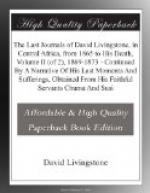I now spoke with my friend Mohamad, and he offered to go with me to see Lualaba from Luamo, but I explained that merely to see and measure its depth would not do, I must see whither it went. This would require a number of his people in lieu of my deserters, and to take them away from his ivory trade, which at present is like gold digging, I must make amends, and I offered him 2000 rupees, and a gun worth 700 rupees, R. 2700 in all, or 270_l._ He agreed, and should he enable me to finish up my work in one trip down Lualaba, and round to Lualaba West, it would be a great favour.
[How severely he felt the effects of the terrible illnesses of the last two years may be imagined by some few words here, and it must ever be regretted that the conviction which he speaks of was not acted up to.]
The severe pneumonia in Marunga, the choleraic complaint in Manyuema, and now irritable ulcers warn me to retire while life lasts. Mohamad’s people went north, and east, and west, from Kasonga’s: sixteen marches north, ten ditto west, and four ditto E. and S.E. The average march was 6-1/2 hours, say 12’ about 200’ N. and W., lat. of Kasongo, say 4 deg. south. They may have reached 1 deg., 2 deg. S. They were now in the Balegge country, and turned. It was all dense forest, they never saw the sun except when at a village, and then the villages were too far apart. The people were very fond of sheep, which they call ngombe, or ox, and tusks are never used. They went off to where an elephant had formerly been killed, and brought the tusks rotted and eaten or gnawed by “Dere” (?)—a Rodent, probably the Aulocaudatus Swindermanus. Three large rivers were crossed, breast and chin deep; in one they were five hours, and a man in a small canoe went ahead sounding for water capable of being waded. Much water and mud in the forest. This report makes me thankful I did not go, for I should have seen nothing, and been worn out by fatigue and mud. They tell me that the River Metunda had black water, and took two hours to cross it, breast deep. They crossed about forty smaller rivers over the River Mohunga, breast deep. The River of Mbite also is large. All along Lualaba and Metumbe the sheep have hairy dew-laps, no wool, Tartar breed (?), small thin tails.
A broad belt of meadow-land, with no trees, lies along Lualaba, beyond that it is all dense forest, and trees so large, that one lying across the path is breast high: clearances exist only around the villages. The people are very expert smiths and weavers of the “Lamba,” and make fine large spears, knives, and needles. Market-places, called “Tokos,” are numerous all along Lualaba; to these the Barua of the other bank come daily in large canoes, bringing grass-cloth, salt, flour, cassava, fowls, goats, pigs, and slaves. The women are beautiful, with straight noses, and well-clothed; when the men of the districts are at war, the women take their goods to market as if at peace and are never molested: all are very keen traders, buying one thing with another, and changing back again, and any profit made is one of the enjoyments of life.




